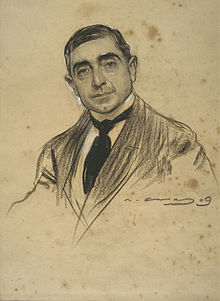Dionisio Baixeras Verdaguer
- Machine translation, like DeepL or Google Translate, is a useful starting point for translations, but translators must revise errors as necessary and confirm that the translation is accurate, rather than simply copy-pasting machine-translated text into the English Wikipedia.
- Do not translate text that appears unreliable or low-quality. If possible, verify the text with references provided in the foreign-language article.
- You must provide copyright attribution in the edit summary accompanying your translation by providing an interlanguage link to the source of your translation. A model attribution edit summary is
Content in this edit is translated from the existing Catalan Wikipedia article at [[:ca:Dionís Baixeras i Verdaguer]]; see its history for attribution. - You may also add the template
{{Translated|ca|Dionís Baixeras i Verdaguer}}to the talk page. - For more guidance, see Wikipedia:Translation.
Dionisio Baixeras Verdaguer | |
|---|---|
 Baixeras seen by Ramon Casas (MNAC) | |
| Born | Dionís Baixeras i Verdaguer 23 November 1876 Barcelona, Catalunya, Spain |
| Died | 1943 Barcelona |
| Nationality | Catalan |
| Education | Martí Alsina and Antonio Caba |
| Known for | Painter |
| Movement | Orientalist |
Dionís Baixeras i Verdaguer (1862–1943) was a naturalist Spanish artist from Barcelona, who specialized in oil on canvas and was noted for his realistic and detailed Orientalist and everyday life scenes.
Early life
Baixeras was born in Barcelona in 1862.
Career
Baixeras began studying at an early age at the La Lonja School of Fine Arts, where he was a pupil of Catalan painters such as Agustín Rigalt (1836-1899), Martí Alsina (1826-1894) and Antonio Caba (1838-1907).
He and his brothers, Juan and Jose Llimonas, were members of a group, which included painters and sculptors, known as the Cercle Artístic de Sant Lluc (Artistic Circle of San Lluc); an arts society formed in Barcelona in the early 1890s by brothers, Joan Llimona and Josep Llimona; Antoni Utrillo, Alexandre de Riquer and a group of artists who were followers of bishop Josep Torras i Bages. This circle also included the celebrated architects, Gaudí and Puig i Cadafalch.[1]
At age 24 he moved for 4 years to Paris,[2][3] where he frequented the countryside to make paintings. In Paris, he was impressed by the realism and naturalism of Jean-François Millet, Jules Bastien-Lepage and Pascal Dagnan-Bouveret, whose style would leave a lasting impression on the young artist. He then returned to Barcelona.
Baixeras exhibited often and with the help of Antonio Blanch, he sold many paintings. The everyday scenes he painted ensured that his work was popular, and he was commercially successful.[4]
Personal life
Baixeras was married.[5]
Work
His works have variously been described as Orientalist and Costumbrista.
His works hang in several museums including:
His more well-known paintings include:
- Abd al-Rahman III Receiving the Ambassador at the Court of Cordoba, 1885
- Alphonse X, the Wise with his Collaborators
-
 Knitting, 1888, Museu Nacional d'Art de Catalunya
Knitting, 1888, Museu Nacional d'Art de Catalunya -
 Boatmen of Barcelona, 1886
Boatmen of Barcelona, 1886
See also
References
- ^ Caso, E.D., Les Orientalistes de l'école Espagnole, ACR edition, 1997, p. 24 (translated from French)
- ^ "Dionís Baixeras i Verdaguer | enciclopèdia.cat".
- ^ "Baixeras i Verdaguer, Dionís | Colección".
- ^ Caso, E.D., Les Orientalistes de l'école Espagnole, ACR edition, 1997, p. 24 (translated from French)
- ^ "CX00627 Portrait of the Painter's Wife | Colección".














